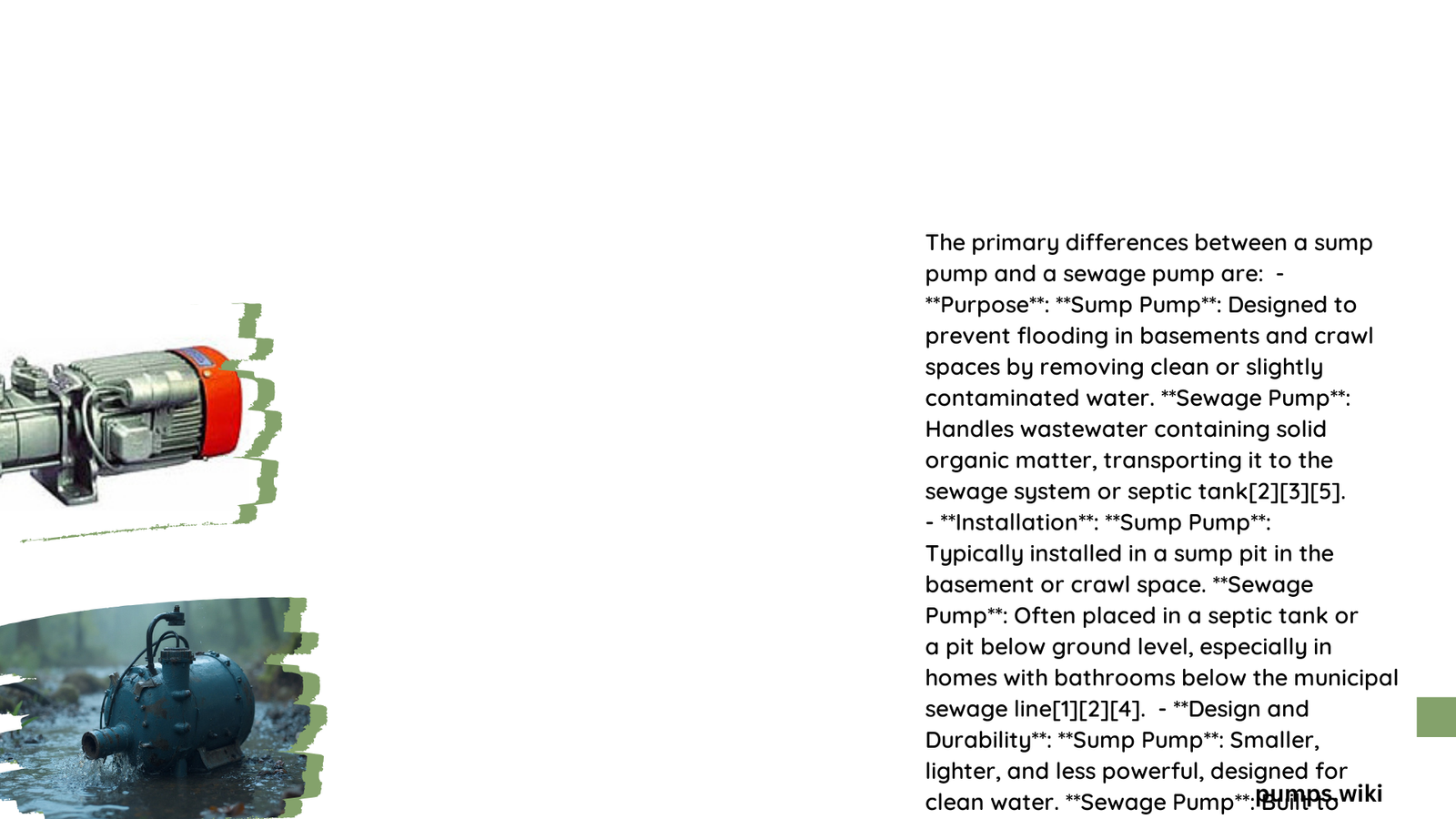Homeowners often confuse sump pumps and septic pumps, but these two systems serve distinctly different purposes. While sump pumps remove excess water from basements to prevent flooding, septic pumps handle wastewater and solid waste from household plumbing systems. Understanding their unique characteristics is crucial for proper home maintenance and preventing potential water-related disasters.
What Defines a Sump Pump?
Sump pumps are specialized water management devices designed to protect homes from water accumulation and potential flooding. These systems are typically installed in the lowest point of a basement or crawl space, creating a critical defense against water damage.
How Do Sump Pumps Operate?
| Feature | Sump Pump Characteristics |
|---|---|
| Water Type | Clear or gray water |
| Location | Basement or crawl space |
| Purpose | Prevent water accumulation |
| Flow Rate | 1,000-5,000 gallons per hour |
Key Components of Sump Pump Systems
- Sump pit or basin
- Submersible or pedestal pump
- Float switch
- Discharge pipe
- Optional battery backup
What Distinguishes a Septic Pump?

Septic pumps, in contrast, are specialized wastewater management systems designed to handle solid waste and sewage from household plumbing systems. These pumps play a critical role in managing waste when municipal sewage systems are unavailable.
What Makes Septic Pumps Unique?
| Feature | Septic Pump Characteristics |
|---|---|
| Water Type | Wastewater with solid waste |
| Location | Underground sewage basin |
| Purpose | Transport sewage to septic tank |
| Flow Rate | Up to 20 gallons per minute |
Essential Septic Pump Features
- Grinder mechanism
- Higher horsepower
- Robust construction
- Complex plumbing connections
What Are the Primary Functional Differences?
Can You Interchange Sump and Septic Pumps?
Absolutely not. These pumps are engineered for entirely different purposes and are not interchangeable. Attempting to use a sump pump for sewage or a septic pump for water removal could lead to catastrophic system failures.
What Determines Their Unique Applications?
- Sump Pump Applications
- Basement water management
- Groundwater redirection
- Flood prevention
-
Moisture control
-
Septic Pump Applications
- Sewage transportation
- Solid waste processing
- Wastewater management
- Septic system maintenance
What Are the Cost Implications?
How Much Should You Budget?
- Sump Pump Costs
- Initial investment: $100-$500
- Lifespan: 5-10 years
-
Maintenance: Low complexity
-
Septic Pump Costs
- Initial investment: $500-$2,000
- Lifespan: 10+ years
- Maintenance: Higher complexity
What Installation Considerations Exist?
Where Should These Pumps Be Installed?
Sump Pumps require:
– Basement or crawl space access
– Proper drainage pathway
– Minimal professional intervention
Septic Pumps demand:
– Professional installation
– Specific plumbing connections
– Compliance with local regulations
– Potential permit requirements
What Environmental Impacts Should You Consider?
How Do These Pumps Affect Your Ecosystem?
- Sump Pumps
- Minimal environmental impact
- Redirects clean water
-
Prevents localized flooding
-
Septic Pumps
- Potential contamination risks
- Requires careful waste management
- Necessitates proper ventilation
Final Recommendations
Understanding the difference between sump pumps and septic pumps is crucial for effective home maintenance. Always consult professionals when installing or maintaining these systems to ensure optimal performance and prevent potential damage.
